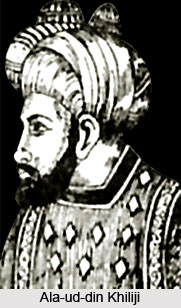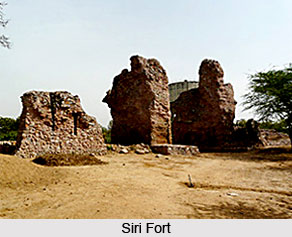 Invasion of the Mongols during the reign of Ala-ud-din Khilji is an important event in the history of medieval India. There were several invasions of the Mongols but the Sultan was successful in suppressing them all. The Mongols threatened the security of India towards the north-west during the entire reign of Ala-ud-din Khilji. Thereafter the Mongols had divided and thereby weakened themselves after the death of their great leader Genghiz Khan, yet they were a power in Asia even at that time. Ghazni and Kabul formed powerful bases to attack India. During the reign of Ala-ud-din their attacks were fiercer as compared to previous ones. Previously, they had attacked India primarily for booty and to extend their sphere of influence. But, now they invaded India either to extend their empire or to take revenge of their defeat and disgrace. Therefore they threatened not only the valley of Punjab but even that of Delhi and Ganga- Yamuna- Doab.
Invasion of the Mongols during the reign of Ala-ud-din Khilji is an important event in the history of medieval India. There were several invasions of the Mongols but the Sultan was successful in suppressing them all. The Mongols threatened the security of India towards the north-west during the entire reign of Ala-ud-din Khilji. Thereafter the Mongols had divided and thereby weakened themselves after the death of their great leader Genghiz Khan, yet they were a power in Asia even at that time. Ghazni and Kabul formed powerful bases to attack India. During the reign of Ala-ud-din their attacks were fiercer as compared to previous ones. Previously, they had attacked India primarily for booty and to extend their sphere of influence. But, now they invaded India either to extend their empire or to take revenge of their defeat and disgrace. Therefore they threatened not only the valley of Punjab but even that of Delhi and Ganga- Yamuna- Doab.
The first Mongol invasion took place in 1297-98 A.D. only a time after Ala-ud-din`s accession on the throne. Dava Khan of Transoxiana sent an army of one lakh Mongols under the command of Kadar. They entered Punjab and started plundering nearby places of Lahore. Ala-ud-din sent an army under Ulugh Khan which defeated the Mongols. While nearly twenty thousand Mongols were killed in the battle, many Mongol officers were taken prisoners who were killed afterwards and their captured women and children were taken to Delhi as slaves. In 1299 A.D., the Mongols attacked again under the command of Saldi, brother of Dava Khan, and captured Sivistan (Sehwan). Ala-ud-din sent Zafar Khan against the Mongols who recaptured Sivistan and imprisoned a large number of Mongols. This surprising victory of Zafar Khan invoked the jealousy both of the Sultan and his brother Ulugh Khan and the success in Multan and Gujarat was eclipsed by the achievement of Zafar Khan. The Sultan even desired to kill Zafar Khan.
Towards the close of 1299 A.D., Dava Khan sent a strong army under the command of his son to avenge the disgrace and death of Saldi. This time the Mongol did not mean to plunder but conquest. They avoided fighting till they reached the neighbourhood of Delhi. At that time, Ala-ud-din rose equal to the occasion and gave proof of being a courageous commander. The Mongols had firm determination to fight against Ala-ud-din. Therefore, Ala-ud-din decided to give them a battle even against the counsel of Ala-ul-mulk who advised him to wait and avoid the risk of a battle. He assembled all his high officers of the army and attacked the left wing of the Mongols. Zafar Khan was killed in the combat but the Mongols had tested the strength of the army of Ala-ud-din. They had to withdraw thirty kilometres back from Delhi and then returned to their country.
 Fourth Mongol invasion took place only after a few months of Ala-ud-din`s return from Chittor in 1303 A.D. The Mongols number under the command of Targhi, moved cautiously so that provincial governors could not get time to reach to help the Sultan. Besides, a large part of the army of the Sultan had left for Telengana campaign and the army left at Delhi was insufficient and weak after its tough battle at Chittor. Therefore,
Ala-ud-din was not in a position to face the Mongols. He retired to the fort of Siri and took up defensive position. Mongols plundered the environs of Delhi and besieged the fort for months. But they failed to capture the fort and withdrew. Ala-ud-din made Siri his capital, strengthened its fortification repaired the fort of Delhi and those in the north-west, constructed a few new ones there, kept standing armies in them, kept permanent army for the defence of the north-west and appointed a separate governor for the same.
Fourth Mongol invasion took place only after a few months of Ala-ud-din`s return from Chittor in 1303 A.D. The Mongols number under the command of Targhi, moved cautiously so that provincial governors could not get time to reach to help the Sultan. Besides, a large part of the army of the Sultan had left for Telengana campaign and the army left at Delhi was insufficient and weak after its tough battle at Chittor. Therefore,
Ala-ud-din was not in a position to face the Mongols. He retired to the fort of Siri and took up defensive position. Mongols plundered the environs of Delhi and besieged the fort for months. But they failed to capture the fort and withdrew. Ala-ud-din made Siri his capital, strengthened its fortification repaired the fort of Delhi and those in the north-west, constructed a few new ones there, kept standing armies in them, kept permanent army for the defence of the north-west and appointed a separate governor for the same.
The Mongols attacked again in 1305 A.D. under the command of Tartaq. Targi also joined them in the way. The strong Mongols could reach up to Amroha where it met the army of the Sultan under the command of Malik Kafur. The royal army completely defeated the Mongols on December 1305 A.D. Targi had died earlier in a battle and Ali Beg and Tartaq were taken captives. They were brought to Delhi where they were killed.
In 1306 A.D., the Mongols attacked again to take revenge of Ali Beg and Tartaq. One of their strong force, under the command of Kubak, reached the banks of the Ravi River while other one, under the command of Iqbalmand reached to Nagaur. Ala-ud-din had again sent Ghazi Malik and Malik Kafur to repulse the invaders. They first met Kubak and defeated and imprisoned him. Fifty thousand of Mongols were imprisoned and brought to Delhi where males were trampled under the feet of elephants and a tower of skulls was constructed in front of the Badaon Gate while the women and children were sold as slaves.
Last Mongol invasion took place in 1307-8 A.D. Thus, most fierce invasions of the Mongols took place during reign of Ala-ud-din Khilji. Yet, he succeeded in defeating the Mongols. Therefore, the Mongols did not dare to attack India during last years of his reign. The aggressive policies of the Sultan and his able commanders broke up the capacity of the Mongols to invade India.



















